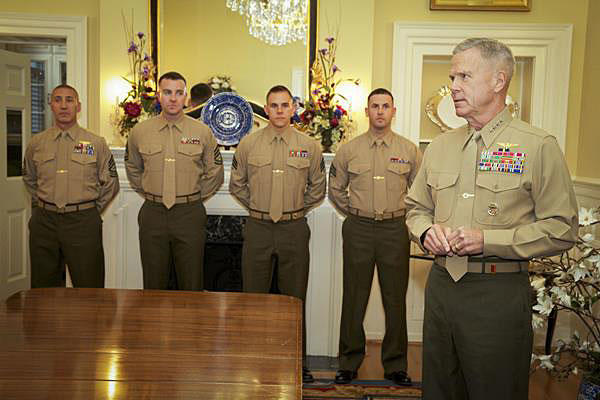Starting next year, the Pentagon may have to justify to Congress the number of enlisted aides the services' admirals and generals keep in attendance.
A provision of the 2015 National Defense Authorization Act mandates that the defense secretary report to Congress each year the number of enlisted aides and "[justify], on a billet-by-billet basis, the authorization and assignment of each enlisted aide to each general officer and flag officer position.''
"In developing the report," the budget provision states, "the Secretary of Defense shall have the objective of reducing the maximum number of enlisted aides" by making sure each can be justified.
"I think that's great progress," said Ben Freeman, senior policy adviser on national security at Third Way, a public policy think tank in Washington, D.C. Freeman has written on the rising number of generals and admirals across DoD -- what he calls "star creep" -- for Third Way and, before that, for Project on Government Oversight.
Though the 2015 budget does not call for drawing down the number of flag and general officers, Freeman said forcing generals and admirals to justify their enlisted aides is a good step in the right direction.
"That's really where the high cost of ... 'star creep' comes from -- the number of people working for and beneath these generals and admirals," Freeman said on Thursday.
A September 2014 General Accountability Office report on flag and general officer aides -- enlisted and officer -- said the Army, Navy and Marine Corps did not have sufficient data on numbers to properly query DoD for costs associated with their duties, including travel.
Data provided by the Air Force, however, showed that annual travel and per diem costs for enlisted and officer aides grew from about $862,000 in fiscal 2007 to about $1.3 million in 2010, before decreasing to $768,000 in fiscal 2013.
The 2015 NDAA means Congress will get all the numbers. The budget still has to be passed by both the Senate and the full Congress after the Senate and House armed services committees on Wednesday agreed on a version to send to the chambers.
There are currently more than 900 flag and general officers across the armed forces, though the Pentagon -- in keeping with recommendations made by Defense Secretary Robert Gates in 2010 -- plans to draw down that number by just over 100 once the U.S. wraps up the war in Afghanistan, according to Freeman.
According to the GAO, the number of enlisted aides is supposed to be limited by statute to 300 per year. That number has not changed since 1976.
In fact, the Defense Department does not know how many enlisted aides there are and does not know how much they cost, the GAO reported.
The Pentagon told the GAO as it compiled the September report that it would reinstate a biannual report on enlisted aides but could not say when that would happen.
The NDAA provision would make it happen starting next year, and not on a biannual basis.
Not later than June 30, 2015, according to the proposed law, the defense secretary will have to provide the House and Senate armed services committees a list of all military duties that the service secretaries authorize enlisted aides to perform for flag and general officers.
They will also have to state what duties they consider it necessary for the enlisted personnel to do rather than officer aides. The argument for enlisted personnel carrying out "minor duties" is that it frees up officer aides to perform their primary military or official duties.
-- Bryant Jordan can be reached at bryant.jordan@military.com.























